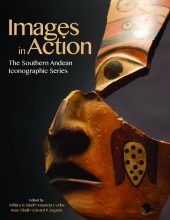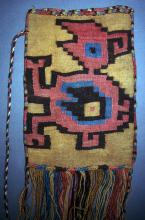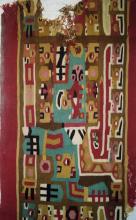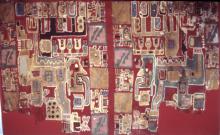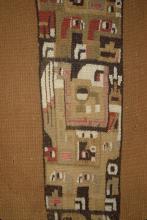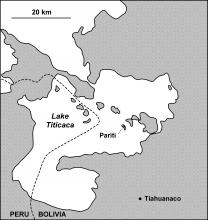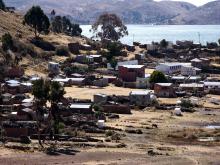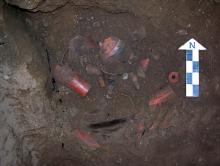Visual database
Nasca 9, represented on a bag in interlocking tapestry, with cotton warp and weft in camelid fibers, is an unusual creature, dated cal. AD 659 to 771 (SH 677-865). A typical Nasca 9 severed head (shown upside down) appears within the creature's body and a second severed head (also shown upside down) becomes the creature's head. Private collection.
Nasca 9, bag with iconography executed in embroidery on plain weave, dated cal. AD 664 to 769 (SH 684-861). Private collection.
Postincursion SAIS, fragment of a striped tunic with a representation of a Winged Feline Anthropomorphic Attendant, dated cal. AD 687 to 870 (SH 773-944). Weft in camelid fibers and cotton warp. Private collection.
Postincursion SAIS, Robles Moqo style, detail of a partially preserved tunic in interlocking tapestry with representations of Winged Anthropomorphs arranged between tocapu-like motifs, dated cal. AD 779 to 966 (SH 890-988). Weft in camelid fibers and cotton warp. Private collection.
Tiwanaku, detail of a partially preserved striped tunic in interlocking tapestry with representations of an Anthropomorphic Bird Attendant, dated cal. AD 694 to 870 (SH 778-895). Weft and single strand warp (horizontal as worn) in camelid fibers. Made in one piece with woven-in neck opening (middle of upper portion of Figure). Private collection.
Tiwanaku, detail of a striped tunic in interlocking tapestry with representations of an Anthropomorphic Bird Attendant, dated cal. AD 986 to 1043 (SH 1023-1152). The tunic is made in one piece with woven-in neck opening. Weft and single warp (horizontal as worn) in camelid fibers. Private collection.
Provincial Pukara, represented on the front panel of a pouch with the three typical side tabs and a backflap are two rows, one above the other, of three differently colored superimposed ascending and descending steps with intercalated checkered crosses. Private collection.
Map of the smaller part of Lake Titicaca and surrounding areas showing the location of the island of Pariti and the Tiahuanaco site.
View of the present-day community of Pariti (facing north-northwest). The offering pits, Features 1 and 2, were discovered near the northwest corner of the football field. The excavation is visible in the center of the photo.
Ceramics in situ in Pariti's Feature 2, at a depth of around 205 cm.
